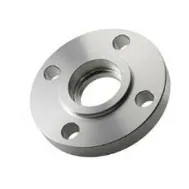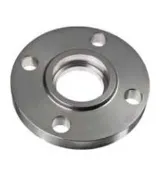"EN 1092 SS 904L SO Flanges" refers to the flat-neck welding flange with 904L stainless steel that complies with the EN 1092 standard. The following is a brief introduction:
Standard Specification
EN 1092 standard: specifies the requirements for the dimensions, tolerances, design, materials and testing of flanges and their connectors to ensure that flanges have good interchangeability and reliability in different application scenarios.
Material Properties
Chemical composition: 904L stainless steel is a high-alloy austenitic stainless steel containing about 24-26% chromium (Cr), 19-23% nickel (Ni), 4-5% molybdenum (Mo) and a small amount of copper (Cu) and other elements. The low carbon content is usually not more than 0.02%.
Mechanical properties: It has high strength and good toughness. Its yield strength is generally not less than 220MPa, its tensile strength is not less than 490MPa, and its elongation is not less than 35%.
Corrosion resistance: Due to its high chromium, nickel and molybdenum content, 904L stainless steel has excellent corrosion resistance to a variety of corrosive media, especially in complex acidic environments such as sulfuric acid, phosphoric acid, formic acid and chloride environments, and can effectively resist pitting, crevice corrosion and stress corrosion cracking.
Machinability: Although the processing difficulty of 904L stainless steel is slightly higher than that of ordinary stainless steel, it can still be processed by forging, rolling, welding and cutting through appropriate processing technology and equipment to make necked flat welding flanges that meet various needs.
Structural features
Necked flat welding connection: Similar to other necked flat welding flanges, EN 1092's 904L SO flange also has a short neck structure. The pipe is inserted into the inner diameter of the flange and then welded on the outside. The short neck can enhance the strength and rigidity of the flange, facilitate installation and alignment, and is suitable for pipe connections within a certain pressure and pipe diameter range.
Flange surface form: Common ones include raised face (RF) and full plane (FF) to meet different sealing requirements and working conditions.
Application fields
Chemical industry: widely used in various complex chemical production processes, such as the production and transportation pipelines of strong acids such as sulfuric acid and phosphoric acid, and pipeline systems for handling corrosive media such as high concentrations of chlorides.
Environmental protection industry: in environmental protection projects such as sewage treatment and garbage incineration, it is used for connecting pipelines that come into contact with corrosive wastewater and exhaust gas, which can effectively resist corrosion and ensure the stability and service life of the pipeline system.
Marine engineering: in marine environments such as seawater desalination and offshore oil platforms, due to its excellent seawater corrosion resistance, it can be used for related pipeline systems such as seawater transportation and seawater treatment.
Pharmaceutical and food industry: in the pharmaceutical and food processing fields with extremely high requirements for hygiene and corrosion resistance, it is used for pipelines such as drug production and food transportation, which meet relevant hygiene standards and ensure product quality and safety.
















